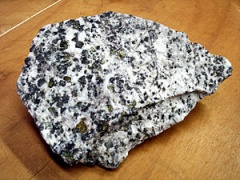Carbonatites
| Infobox on Carbonatites | |
|---|---|
| Example of Carbonatites |  |
| Facts | |
| Origin | - |
| Stowage factor (in m3/t) | - |
| Humidity / moisture | - |
| Ventilation | - |
| Risk factors | - |
Carbonatites
Descrption
Carbonatites are intrusive or extrusive igneous rocks defined by mineralogic composition consisting of greater than 50 percent carbonate minerals. Carbonatites may be confused with marble, and may require geochemical verification.
Carbonatites usually occur as small plugs within zoned alkalic intrusive complexes, or as dikes, sills, breccias, and veins. They are, almost exclusively, associated with continental rift-related tectonic settings. The majority of carbonatites are Proterozoic or Phanerozoic in age. It seems that there has been a steady increase in the carbonatitic igneous activity through the Earth's history, from Archean to present.
Nearly all carbonatite occurrences are intrusives or subvolcanic intrusives. This is because carbonatite lava flows are unstable and react quickly in the atmosphere. Carbonatite lavas may not be as uncommon as thought, but have been poorly preserved throughout Earth's history.
Only one carbonatite volcano is known to have erupted in historical time, Ol Doinyo Lengai in Tanzania. It erupted the lowest temperature lava in the world, at 500-600 °C. The lava is natrocarbonatite dominated by nyerereite and gregoryite.
Carbonatite is composed predominatly of carbonate minerals and extremely unusual in its major element composition as compared to silicate igneous rocks, obviously because it is composed primarily of Na2O and CaO plus CO2.
Most carbonatites tend to include some silicate mineral fraction; by definition an igneous rock containing >50% carbonate minerals is classified as a carbonatite. Silicate minerals associated with such compositions are pyroxene, olivine, and silica-undersaturated minerals such as nepheline and other feldspathoids.
Carbonatites may contain economic or anomalous concentrations of rare earth elements, phosphorus, niobium - tantalum, uranium, thorium, copper, iron, titanium, vanadium, barium, fluorine, zirconium, and other rare or incompatible elements. Apatite, barite and vermiculite are among the industrially important minerals associated with some carbonatites.
Vein deposits of thorium, fluorite, or rare earth elements may be associated with carbonatites, and may be hosted internal to or within the metasomatized aureole of a carbonatite.
Application
Carbonates may be used in local portland cement industries.
Carbonatites are the main source of niobium and important sources of rare earth elements, but have to compete for the market with placer deposits and offshore placer deposits (Brazil, Australia, India, Sri-Lanka). They compete with sedimentary phosphate deposits for a portion of the phosphate market.
Shipment / Storage
Shipped in bulk as minerals.
Risk factors
For transport guidelines consult the IMSBC Code (International Maritime Solid Bulk Cargoes Code).











